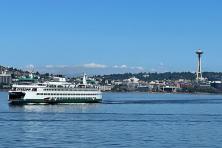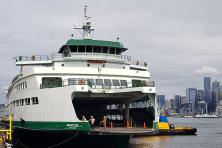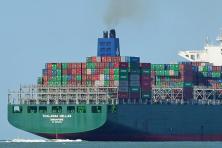Standing on the water’s edge, looking out across the Pacific Northwest, it is easy to be taken in by the views and the peaceful feeling. While at the ocean beach or while standing on the shoreline of the Columbia River or Puget Sound you usually do not have to wait long before you see a large commercial vessel carrying cargo pass by. Waterways and ports have shaped the current landscape of the region: many of our towns and cities are located where they are because of their access to navigable water. When looking out at those vessels plying our waters or at our port facilities, do you think of pollution?
If viewed as a country, the marine sector would be the 6th largest contributor to global climate pollution, responsible for about 3% of global greenhouse gas (GHG) emissions. Recent figures on the global marine industry estimate that more than 60,000 commercial vessels are moving 11 billion metric tons of cargo annually. This amounts to 80% of world trade. From computers to clothes, cereal to bananas, there’s a good chance that most of the items you interact with everyday have spent time on a ship. Since the 1980s, the size of container ships has quadrupled, driven by a consumer desire for more goods delivered faster and at a lower price. Moving commodities comes at a cost; with shipping producing 1 billion metric tons of climate pollution each year. On top of these emissions, vessels contribute to marine noise pollution, oil discharge, and invasive species transported in ballast water tanks. Researchers have linked shipping pollution to an estimated 250,000 premature deaths annually and 6.4 million cases of asthma in children. Left unchecked, global shipping pollution is projected to increase “by 20-50% between 2008 and 2050 in the business as usual scenarios.”
The sheer scale of ships presents an especially challenging problem. One single container ship can carry 4.5 million gallons of fuel in its tanks. That’s more fuel than is sold in the entire state of Oregon in a single day. A similar vessel may burn between 40,000 and 100,000 gallons of fuel a day. Yet despite those huge numbers marine shipping remains the most efficient way to move weight over distance. The global shipping trade is a complex system as anyone who was waiting for items during the supply chain backups and port congestion at the height of the COVID pandemic might remember. It will require concerted international, national, and local efforts to address pollution from this sector. Solutions are in sight as alternative fuel and engine technologies advance. We do not need to wait for the newest technology to begin. Existing stopgaps such as shore power (plugging a ship into the local electrical grid) and slow steaming (sailing slower that reduces fuel burn) can be utilized to minimize the shipping sector's pollution in the short term.
In early July, the International Maritime Organization (IMO), the body of the United Nations that regulates shipping, met to discuss a new agreement on emissions. The results of the meeting were disappointing. The IMO failed to set goals in line with the Paris Agreements to limit warming to 1.5℃. The IMO did include measures to “strive for 30% GHG reductions by 2030” and “80% GHG reductions by 2040.” The IMO also agreed to measure GHG impacts from “well-to-wake” to account for the methane (CH4), nitrous oxide (N2O), and carbon(CO2) emissions. The IMO will revisit its climate strategy in 2028 and hopefully adopt more aggressive measures. Until the IMO takes action it will be left to national and regional governments to pursue climate- friendly maritime policies.
The Pacific Northwest is well positioned to be a leader in a sustainable maritime future. The region participates in many different maritime sectors allowing for a diversity of participation. Shipyards and marine fabrication infrastructure already exist to take on new projects. There is a workforce with existing skills to design, build, and sail more sustainable vessels. Perhaps most importantly there is a strong maritime tradition that starts with the Indigenous use of our waterways and continues to be a strong part of the Northwest tradition. What is required is the political will and strategy to enable a transition that will benefit all. Both Washington and Oregon state governments can play a leadership role in implementing policy that cuts maritime pollution if they choose—and we will work to make sure they do.
State-based approaches to marine emissions exist. Thanks to their unique legal authority to set vehicle emission standards, California has been leading the way in targeting marine pollution through policies that require large commercial vessels to use electric shore power and burn a lower sulfur fuel. California has also implemented a wide ranging regulation to cut pollution from commercial small harbor craft including ferries, tugs, barges, dredging, and many other sectors. These policies provide other states with a template for action. Of course, there is a lot of room for states, ports, cities, and others to be creative and find solutions. In addition to the climate benefits port communities may see substantial health benefits. According to a report from the International Council on Clean Transportation significant reductions in port emissions “would avoid 3 premature deaths per year in Seattle and represents over $27 million in public health benefits per year.”
At Climate Solutions, we know pathways can be found. To address this critical, regionally relevant issue we have added the maritime sector to our work. As the Maritime Policy Manager, I will be working to address these issues. I formerly worked as a merchant mariner, and I am committed to making the industry more sustainable for the environment and for people. Shipping can and must change course to address the climate crisis. As the maritime policy program grows and evolves at Climate Solutions, we look forward to working towards solutions that create a sustainable maritime sector in the Pacific Northwest that is in line with our climate targets. By embracing the strengths of the region, we can set an example and share solutions for others to look to as they address their own maritime challenges.




